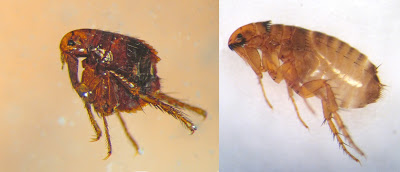Before I let the "cat flea" out of the bag, one of the fleas below was the flea I saw this week. Can you identify which is the one that was not a cat flea? (Hint: it doesn't have anything to do with the color, length of the body, or shape of the flea)
 |
| Click on image for a better view. Photos by M. Merchant. |
If you guessed the flea on the left was my mystery flea, you'd be correct. But did you guess right for the right reason?
First, it wasn't the legs. Both fleas are "host fleas", which means they live most of their adult lives on a host. Host fleas must have strong jumping legs to gain access to this host. Nest fleas, on the other hand, live in the nests of their hosts (usually rodents or birds), only living on the host long enough to take a blood meal and returning to the nest after dinner. Nest fleas rely less on jumping and and more on crawling within the nest to feed, so the third pair of legs is more like the second pair in size.
The big difference between these two fleas is the presence or absence of dark, comb-like bristles on the face and behind the head. The cat flea has combs both above the mouth (called a genal comb) and on the tail-edge of the first thoracic segment (pronotal comb) behind the head. Fleas with both genal and pronotal combs are relatively rare, narrowing down their probable identity considerably. Most fleas found indoors with two combs like this in homes are either cat fleas, Ctenocephalides felis, or dog fleas, Ctenocephalides canis.
The flea on the left lacks both a genal and a pronotal comb, ruling out cat flea. This flea is a human flea, Pulex irritans. The human flea, like the cat flea, has many potential hosts including small mammals, canines, pigs, humans, and even burrowing owls.
Entomologists have identified over 2,500 different kinds of fleas from around the world. Most of these fleas are highly fussy about their food, feeding on the blood of only one or a few closely related kinds of hosts. These two fleas are exceptions. Besides cats, the cat flea gladly feeds on dogs, opossums, raccoons (two frequent wildlife hosts that can bring fleas into homes when pets are not present), foxes, skunks, cattle, rats and rabbits, to name a few. [Curiously, squirrels do not seem to be a listed host of cat fleas, so are not likely to be the source of fleas in homes with no cats or dogs.]
Why worry about flea identification? Because flea ID may provide clues to a possible source of a flea problem. If fleas found in a home or on a pet are not cat fleas, it's possible that the fleas are coming from rodents or other wildlife. For example, rat fleas may suggest a rat or mouse infestation. Rat fleas may pose greater risk for the homeowner from flea-borne illness such as murine typhus, or even (more rarely) plague, though the cat flea is not without its own risks. Cat fleas on opossums have been associated with increased cases of murine typhus in California and Texas and other areas. Cat scratch disease may also be carried by cat fleas.
The following key is provided by the Centers for Disease Control (reprinted in the Mallis Handbook of Pest Control) and can help you identify some of the more common fleas found in structures or on pets. Combs can usually be seen by the practiced eye with a good 10X handlens. If you want to see other features in this key, however, you'll need a microscope. A 12X magnification will show genal and pronotal combs; but 25X to 50X is needed to see smaller characters shown on the key.
If you do not see pronotal and genal combs on a flea collected in a home, and do not have a good microscope, it's best to save some specimens in either 70% ethanol or rubbing alcohol. Specimens can then be sent to an entomologist for positive identification. Five or more pointed teeth on both the genal and pronotal sites will narrow any flea found on a pet or in a building down to a cat or dog flea, both of which have similar host ranges and control measures.
 |
| Click on key for a better view. |
Next time you get your hands on some fleas, take a closer look. Check for combs and use the key. I predict you'll get that same thrill of satisfaction entomologists get when being able to put a name on something that most people can barely see. Your customers will be impressed too.
No comments:
Post a Comment